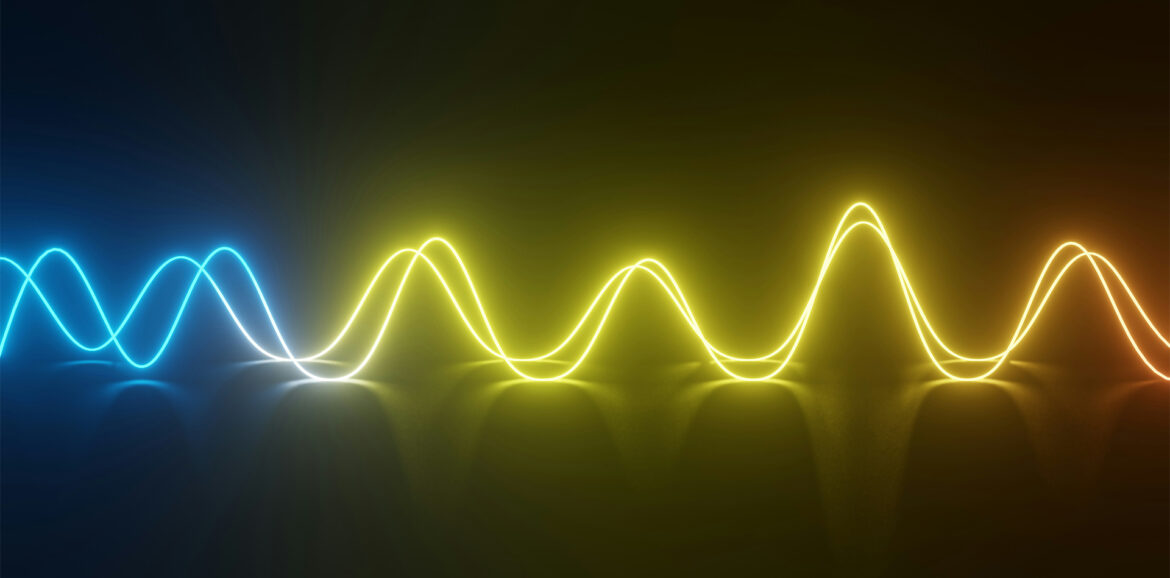If you’ve ever watched a sound wave – on an app, at a sound meter or just on TV – chances are you’ve seen a graph with peaks and valleys. That wave motion says something about the sound. And one of the most important concepts in such a wave, is amplitude. But what exactly does it mean? And why is it important when we talk about hearing and hearing protection?
In this blog we explain it to you in full. No complicated theory, just understandable, with examples and practical explanations. Because even though “amplitude” sounds like something for physicists or audio engineers: it also touches your ears. Every day.
Sound = vibration
Back to basics for a moment. Sound is created by vibrations in the air. A voice, an engine, a violin string, a clapping hand – all cause the air to vibrate. Your ears catch those vibrations and your brain translates them into sound.
Such a vibration can be represented as a wave. That wave goes up and down, with a certain speed (frequency, measured in hertz – we also wrote a blog about that) and a certain height. And that’s where amplitude comes in.
Amplitude = the strength of the vibration
The amplitude of a sound wave tells something about the strength or intensity of the vibration. Simply put, the greater the amplitude, the louder the sound. You can compare it to the height of waves at sea. Low waves are gently lapping water. High waves? Those are the roaring pounders.
It’s the same with sound. A small amplitude sounds soft, a large amplitude sounds loud. So when you are talking quietly to someone in the living room, your voice has a lower amplitude than when you have to shout loudly at a concert to get above the music.
Amplitude and decibels
Amplitude is not exactly the same as volume, but they are related. We measure loudness in decibels (dB), and that is based on the amplitude of sound waves.
So a sound with a large amplitude usually also has a higher number of decibels. And as you probably know: starting around 85 dB, sound starts to become harmful to your ears if you are exposed to it for too long. Think of festivals, riding a motorcycle without earplugs or hammering a board without hearing protection.
Why amplitude matters to your ears
Your ears are made to pick up subtle vibrations – like the rustle of leaves or a soft voice. But loud sounds (i.e., large amplitudes) put a lot of work on the eardrum. If this happens often or for long periods of time, the inner ear can become overloaded. The cilia in your cochlea become damaged, leading to hearing damage or tinnitus.
That’s why amplitude – even if it sounds technical – is something to take seriously. Especially in a world where loud noises are everywhere: traffic, music, chores, parties, airplanes, gaming, sports games…. Your ears have to put up with a lot every day.
Amplitude on image: what do you see?
If you watch a sound recording, say in an audio app or while editing a video, you often see a graph with those typical waves. The vertical axis then shows the amplitude: how high or deep the peaks and valleys go.
- A soft voice or background sound has narrow, low waves.
- A scream or loud bang? Large, high peaks in the graph.
That visual image helps sound engineers mix music, for example, but it also gives an idea of how loud something is – and whether there is a risk of hearing damage.
Can you measure amplitude by yourself?
Sure! With a decibel meter or decibel app on your phone, you can see in practice how loud your environment is. It does not literally measure the amplitude as in physics, but translates it into a usable dB value. So you can check whether, for example, it’s smart to wear earplugs at the gym, while working with machinery or at your favorite concert.
A useful tool, then, if you want to be economical with your hearing – and that’s no luxury.
Earplugs: your filter for amplitude
Fortunately, you don’t have to stay away from anything loud. With good earplugs, you can still enjoy music, go for a motorcycle ride or go to a race, without it bothering your ears. This is because earplugs reduce the amplitude of the sound entering your ears. Not by taking away the sound, but by making it softer.
There are several types:
- Universal earplugs With music filter: perfect for festivals or concerts
- Custom-made earplugs: maximum comfort and protection
- Ear muffs: good for extremely loud situations such as construction sites or track days
- Combinations of caps and hoods: for children or people with extra sensitive ears
That way you choose what suits you and the situation, and your ears stay healthy.
In summary, amplitude is the power of sound
Let’s recap:
- Amplitude = the height of the sound wave
- The greater the amplitude, the louder the sound
- Large amplitude = more chance of hearing damage
- Earplugs help by lowering the amplitude reaching your ears
- Smart measurement and protection helps you enjoy your hearing for a long time
In conclusion
Whether you love loud music, stand in a noisy workplace or have a child who loves gaming with headphones: it pays to understand something about sound waves and amplitude. It helps you make conscious choices. Not from fear, but from care. For your ears, and therefore for your well-being.
Because if there’s íthing you want to take care of, it’s those two tiny, sensitive gatekeepers on the side of your head.
Would you like extra protection for your hearing or are you curious about the right hearing protection for your situation? Then of course we will be happy to help you further, please feel free to contact us!








